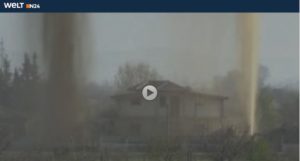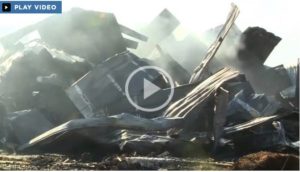March 7, 2017
The week was full of news of the intentions – and lack of attention – of imperial power wielded against people. It was a dreadful spectacle, but a bracing reminder that we are engaged in a timeless struggle with power, until the social paradigm is changed from one chiefly concerned with wielding power into a paradigm of working in acknowledgement that we are all interconnected – ‘interbeing’ to use Thich Nat Hanh’s phrase – with each other, all life, and that we are the Earth itself, not its stewards. Until then our work amounts, one way or another, to the relief of suffering.
But first the news.
Proposed SEQR Regulations: developers and SEQR-adverse agencies win, the environment and public lose
When a government agency talks about “streamlining” environmental regulations, and increasing “speed and efficiency” and “regulatory certainty for applicants and municipalities,” you can be certain that the effect (if not the conscious intent) will be decreased environmental protections and a reduction in the public’s ability to meaningfully participate in the decision-making process. That is precisely what will occur if the current version of the New York State Department of Environmental Conservation’s proposed amendments to the State Environmental Quality Review Act’s regulations are adopted without significant changes.
The last thing New York should be doing is weakening its environmental review process when – on the national level – the Trump Administration is intent on repealing environmental regulations, weakening environmental enforcement, and allowing more fossil fuel production. [For example, see this and this.] If you agree that NYS should be strengthening, not undermining, its environmental laws, I urge you to analyze the proposed amendments to the SEQR regulations, submit written comments by May 19, 2017 to the New York State Department of Environmental Conservation, Division of Environmental Permits, Attn: James J. Eldred, Environmental Analyst, 625 Broadway, Albany, New York 12233-1750 or by e-mail to: seqra617@dec.ny.gov, and, if possible, participate at the public hearing to be held on March 31, 2017 at 1:00 pm at 625 Broadway, Albany, New York, Public Assembly Room 129.
…One need look no further than the “Needs and Benefits” statement in the DEC’s DGEIS to confirm what a reading of the proposed regulatory changes reflects: the primary motivation for the proposed amendments is to expand the “Type II” list…—Arthur J. Giacalone, “Proposed SEQR regulations: developers and SEQR-adverse agencies win, the environment and public lose,” With All Due Respect, 3/5/17
≈≈≈≈≈≈≈≈≈≈≈≈≈≈≈≈≈≈
Independent power producer model is obsolete
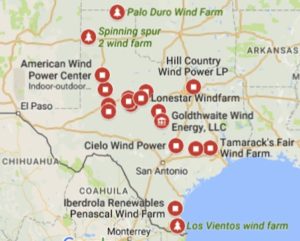
Dive Brief:
- NRG Energy lost almost $900 million last year, the result of lower power and gas prices along with a hefty “goodwill impairment charge.”
- But despite the loss, the big news from the power producer’s earnings came from a comment made to journalists and financial analysts: Mauricio Gutierrez, NRG President and CEO, said the independent power producer model is “now obsolete and unable to create value over the long term.“
- The comments come more than a year after the company reorganized itself, splitting off its renewables and maintaining a fleet of almost 50,000 MW of fossil fuel generation.
Dive Insight:
That independent generators are under significant pressure from low prices in wholesale power markets is no longer news, but the NRG CEO put the situation particularly bluntly in his earnings call this week.
“I want to reiterate my belief that the competitive power sector is in a period of unprecedented disruption,” Gutierrez told journalists and analysts. “I believe the IPP model is now obsolete and unable to create value over the long term.”
A big part of the problem is in Texas, where the company has significant operations. Growing wind energy, lower gas prices and the decline of coal has helped turn the IPP model on its head.
“Changes in fuel mix, consumer preference, technological innovation and increased distributed generation have put pressure on the traditional IPP model, particularly as commodity markets continue to weaken,” Gutierrez said.
The company’s generation segment lost more han $500 million for the full year 2016, alongside renewables losses of more than $300 million. Only NRG’s retail segment showed a profit (about $1 billion).
Gutierrez said that looking ahead, the company expects to continue to streamline the business, focusing on strengthening the balance sheet and delivering value to shareholders.…— Robert Walton, “NRG CEO: Independent power producer model ‘obsolete’,” Utility Dive, 3/1/17
≈≈≈≈≈≈≈≈≈≈≈≈≈≈≈≈≈≈
What Empire Leaves Behind
Confidential Dakota Pipeline Memo:
Standing Rock Not a Disadvantaged Community Impacted by Pipeline
Protesters sing during a march against the Dakota Access oil pipeline near Cannon Ball, North Dakota. Credit: REUTERS/Terray Sylvester
Pipeline builder claimed that mostly white Bismarck communities along its original route would have more minorities impacted than one near tribe’s reservation.
As the Standing Rock Sioux tribe was mounting opposition to the Dakota Access pipeline last spring, the pipeline company told federal officials that its final route skirting the reservation would not impact any minority or impoverished community.
A confidential environmental justice analysis comparing the original proposed route north of Bismarck and the final one upstream of the Standing Rock reservation was sent by Dakota Access LLC employees to senior officials at the U.S. Army Corps of Engineers. Its counterintuitive findings appear to have been largely incorporated into the Corps’ final environmental assessment of the Standing Rock route last July, but weren’t given to the tribe or made public.
The 11-page memo, made available through court records, concludes that the pipeline’s original path near Bismarck would have “more direct and more disproportionate” impacts to minorities. Those communities surrounding Bismarck are 96 percent white and only 2 percent of residents live below the poverty line.
Standing Rock by contrast ranks as one of the nation’s poorest communities. The project will run just over a half-mile upstream of the reservation under Lake Oahe, a Missouri River reservoir used by the tribe for drinking water, irrigation and fish. Three-quarters of its population is Native American and 40 percent of its 8,200 people live in poverty.
The “route does not disproportionately affect low-income or impoverished populations,” the memo said.
The document gets at the heart of the issues in ongoing lawsuits and demonstrations against the Dakota Access pipeline, which opponents believe was unjustly sited near the reservation.
“They’ve gerrymandered the things they are comparing in the analysis to reach an absurd result, which is that the selection of the Oahe crossing instead of the Bismarck route doesn’t have environmental justice implications,” according to Jan Hasselman, an attorney with the environmental law firm Earthjustice. The organization is suing the Army Corps and Dakota Access on behalf of the Standing Rock tribe.
The main complaint is that the company excluded the reservation from the analysis as a result of how it chose census tract data.
“It seems that the analysis and methodology that was set up was designed intentionally to somehow minimize and mask the impacts of this project on the Standing Rock community,” said Robert Bullard, dean of Texas Southern University’s School of Public Affairs who is known as the “father of environmental justice.”
The memo is dated April 12, 2016, less than one month after the Environmental Protection Agency and other federal agencies raised serious environmental justice and other objections to the Standing Rock route. Under the National Environmental Policy Act (NEPA), agencies must consider environmental justice implications of major infrastructure projects.
“I have not seen anything like this,” said JoAnn Chase, director of the EPA’s American Indian Environmental Office under President Obama, referring to the Army Corps’ use of a confidential analysis. “This seems to run counter to everything that I believe is part of an informed process.”
The Interior Department’s top lawyer, solicitor Hilary Tompkins, issued a legal opinion in early December opposing the use of the memo in the analysis.
“The United States cannot fulfill its trust responsibility if it makes decisions with such potentially significant impacts on tribal treaty rights based on confidential, adversarial analysis that the opposing tribe cannot independently review,” Tompkins wrote.
The Trump administration suspended that opinion in February as it prepared to approve the pipeline and halt additional review.…—Phil McKenna, “Confidential Dakota Pipeline Memo: Standing Rock Not a Disadvantaged Community Impacted by Pipeline,” InsideClimate News, 3/6/17
≈≈≈≈≈≈≈≈≈≈≈≈≈≈≈≈≈≈
EPA Scraps Methane Emission Reporting Rule

The Environmental Protection Agency has removed an Obama-era rule that requires oil and gas companies to report methane emissions from oilfields – a rule that had prompted complaints from 11 oil and gas-producing states that argued it required too much work.
The EPA’s new boss, climate change skeptic and former Oklahoma Attorney General Scott Pruitt, said the change was effective immediately, adding he will go on to assess whether the additional information that EPA required from energy companies under its previous management is indeed necessary to collect.
Related reading: House scraps methane standards after Senate kills SEC rule
Pruitt commented that the withdrawal of the methane emission reporting rule was part of the new EPA’s efforts to improve its relationship with state governments. Environmentalist groups were quick to condemn the move, arguing that under Pruitt, the EPA will turn into an organization serving the oil and gas industry. Pruitt was a vocal opponent to EPA’s regulations over the last eight years.
The rule on methane emission reporting, part of efforts to combat climate change by reducing said emissions, was issued in a directive from the EPA in November last year. Besides these reports, the directive also called on 15,000 oil and gas companies to report the numbers and types of equipment at their onshore production sites.…—Irina Slav, “EPA Scraps Methane Emission Reporting Rule,” OilPrice, 3/3/17
≈≈≈≈≈≈≈≈≈≈≈≈≈≈≈≈≈≈
Fracking or not, Albanian village to get compensation for damaged houses
Albanian villagers who accuse an energy company of damaging their homes by fracking will get full compensation, the country’s deputy prime minister said on Wednesday.
A group of the villagers from western Albania walked more than 100 kilometers (62 miles) to the capital Tirana and set up camp outside the energy ministry on Saturday to protest.
In a televised address, deputy prime minister Niko Peleshi said the villagers would get full compensation from the state budget and from the energy company, Bankers Petroleum, following an evaluation of the damage.
The protesters greeted the announcement with cheers of “Zharreza,” the name of the village with the most damaged homes.
Their leader, Qani Rredhi, said that out of 700 houses, 570 were damaged and 70 were not habitable.
“Since 2010 we have suffered earthquake tremors of high intensity at various times, usually at night, even 30 quakes a day,” he told Reuters.…—Benet Koleka, “Fracking or not, Albanian village to get compensation for damaged houses,” Reuters, 3/1/17
≈≈≈≈≈≈≈≈≈≈≈≈≈≈≈≈≈≈
Thousands of spills at US oil and gas fracking sites

The study found that thousands of spills were reported at oil and gas fracking sites in four states. Getty Images.
Up to 16% of hydraulically fractured oil and gas wells spill liquids every year, according to new research from US scientists.
They found that there had been 6,600 releases from these fracked wells over a ten-year period in four states.
The biggest problems were reported in oil-rich North Dakota where 67% of the spills were recorded.
The largest spill recorded involved 100,000 litres of fluid with most related to storing and moving liquids.
Higher numbers
The rapid growth in the extraction of oil and gas from unconventional sources in the US has had a massive impact on the production and consumption of energy over the past ten years.
The key to this expansion has been the use of hydraulic fracturing, the process of injecting fluids with chemical additives under pressure to crack underground rock and release the trapped resources.
However, environmental campaigners have long been troubled by the potential for this process to contaminate water supplies and the environment through leaks and spills.
A study carried out by the US Environment Protection Agency on fracking in eight states between 2006 and 2012 concluded that 457 spills had occurred.
But this new study, while limited to just four states with adequate data, suggests the level of spills is much higher. The researchers found 6,648 spills between 2005 and 2014.
“The EPA just looked at spills from the hydraulic fracturing process itself which is just a few days to a few weeks,” lead author Dr Lauren Patterson from Duke University told BBC News.
“We’re looking at spills at unconventional wells from the time of the drilling through production which could be decades.”
The state reporting the highest level of spills was North Dakota, a hot bed of activity in both oil and gas recovery.
The data recorded 4,453 incidents in the state, much higher than Pennsylvania, Colorado and New Mexico.
This can be explained by reporting requirements. In North Dakota, any spill bigger than 42 US gallons has to be reported while in Colorado and New Mexico the requirement was 210 gallons.
Most of the spills occurred in the first three years of operation. Around 50% of spills were related to the storage and movement of fluids via pipelines. The underlying causes were difficult to determine because of different reporting requirements.
“The causes are quite varied,” said Dr Patterson.
“Equipment failure was the greatest factor, the loading and unloading of trucks with material had a lot more human error than other places.”
A surprising number of spills occurred at wells which had recorded a previous incident, over half in the case of North Dakota. This suggests that targeted inspections on these sites might have a significant impact in reducing spills.…—Matt McGrath, “Thousands of spills at US oil and gas fracking sites,” BBC News, 2/21/17
≈≈≈≈≈≈≈≈≈≈≈≈≈≈≈≈≈≈
Behind Trump’s Push for ‘American Steel’ in Pipelines, Another Russian Company with Putin Ties Stands to Benefit

In his speech at the Conservative Political Action Conference (CPAC) last week, President Donald Trump commemorated the one-month anniversary of his executive orders calling for the approval of the Keystone XL and Dakota Access pipelines, as well as one calling for U.S. pipelines to get their line pipe steel from U.S. facilities.
“I said, who makes the pipes for the pipeline?” Trump told the CPAC crowd. “If they want a pipeline in the United States, they’re going to use pipe that’s made in the United States, do we agree?”
But while the pipe may be made in the U.S., as DeSmog has shown in previous investigations, ownership tells a different story. Enter: TMK IPSCO, a massive producer of steel for U.S. oil country tubular goods (OCTG) and line pipe, and a subsidiary of TMK Group. A DeSmog investigation has found ties between TMK Group’s Board of Directors and Russian President Vladimir Putin.
TMK Group was incorporated in 2001, and in 2008, TMK IPSCO opened its doors as a U.S. subsidiary with a heavy focus on making oilfield pipes on behalf of companies performing hydraulic fracturing (“fracking”) techniques in the Marcellus Shale basin located in the northeast U.S. TMK IPSCO, which has said it wants to be a direct competitor of U.S. Steel Corporation in the Marcellus, also makes steel for companies doing fracking in the Bakken Shale basin, located primarily in North Dakota.…—Steve Horn, “Behind Trump’s Push for ‘American Steel’ in Pipelines, Another Russian Company with Putin Ties Stands to Benefit,” DeSmogBlog, 2/28/17
≈≈≈≈≈≈≈≈≈≈≈≈≈≈≈≈≈≈
Gauging the Carbon Cost of Fuel from Canadian Oil Sands

WELL TO WHEELS: Producing and burning fuel from Alberta oil sands creates about 20% more greenhouse gases than producing and burning fuel from U.S. conventional crude oil.
The oil sands of Canada’s Alberta province are one of the world’s largest oil reserves, currently producing the equivalent of 2 million barrels of crude oil per day. But it takes lots of energy to transform the heavy bitumen in the deposits, which is bound up with sand and clay, into diesel and gasoline. A new study presents a comprehensive analysis of the greenhouse gas emissions associated with fuels from the oil sands—from extracting to shipping to refining to burning—and concludes that emissions are about 20% greater than those from fuels produced from conventionally extracted crude oil in the U.S. (Environ. Sci. Technol. 2015, DOI: 10.1021/acs.est.5b01255).
Currently, only about 9% of crude oil processed by refineries in the U.S. comes from the Canadian oil sands, but analysts project that this share will grow in the future, especially if long-distance pipeline projects such as Keystone XL go forward. Researchers want to understand the carbon footprint of these fuels to help assess their impact on climate, and to track progress toward emission reduction targets. So Hao Cai of Argonne National Laboratory and his colleagues set out to determine the greenhouse gas emissions associated with all the steps involved in production and use of oil sands products refined in the U.S., often called a “well to wheels” life-cycle assessment.
Previous assessments have suffered from limited, proprietary data or were based on less energy-efficient oil production processes than those used today. In the new study, the researchers used publicly available monthly operations data from 27 oil sands projects between 2008 and 2012 and assessed emissions using a model developed at Argonne. The operations data allow the model to estimate emissions resulting from powering the machinery needed to extract oil from the sands, heating steam used in the process, and even from bacteria giving off carbon dioxide and methane in wastewater ponds.… —Deirdre Lockwood, “Gauging The Carbon Cost Of Fuel From Canadian Oil Sands,” Chemical & Engineering News, 6/22/15
≈≈≈≈≈≈≈≈≈≈≈≈≈≈≈≈≈≈
Environmentalists urge French bank not to finance Texas fracking project
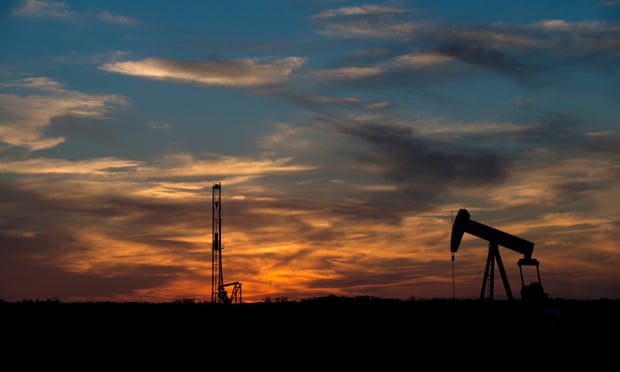
Rigging equipment is pictured in a field outside of Sweetwater, Texas. The French bank BNP Paribas has been urged not to support a fracking project in the state. Photograph: Cooper Neill/Reuters
Environmental groups have called on a French bank not to help finance a fracked-gas export terminal planned for south Texas.
A report released on Wednesday urges BNP Paribas and its US subsidiary, Bank of the West, to state it will not finance any projects for liquefied natural gas (LNG) terminals and to adopt a policy of not backing LNG export schemes. One of the proposals, the Texas LNG terminal, would be built on 1,000 acres of land, potentially making it the largest facility of its kind in the country.
“It’s a destructive fossil fuel infrastructure project in the Gulf coast in one of the relatively untouched parts,” said Jason Opeña Disterhoft of the Rainforest Action Network.
He said there “is some hypocrisy” in BNP’s involvement given that the company touts its green credentials. In the wake of the 2015 Paris agreement to address climate change, the bank said it was committed to responsible investment, such as financing renewable energy rather than coal mining, and minimizing atmospheric pollution as a result of its business activities.
France banned fracking in 2011 for environmental protection reasons. A spokeswoman for BNP’s US operation declined to comment on the report. Texas LNG did not respond to a request for comment.
Rebekah Hinojosa, an activist fighting the terminals, fears that construction would damage sacred Native American historical sites, harm endangered wildlife, tourism and the local shrimping industry and pollute and scar a relatively unscathed part of the coast, as well as threaten safety in the event of a disaster. Though proponents tout potential economic benefits for a deprived area, Hinojosa is concerned that the projects may ultimately cost more jobs than they create.
“That area is the beach of Texas. People come from all over the state and other nearby states to our beach because we are the last industrialized piece of coast along the Texas coastline,” she said. “It doesn’t have a refinery or smoke stacks on the horizon.”…—Tom Dart, “Environmentalists urge French bank not to finance Texas fracking project,” The Guardian, 3/2/17
≈≈≈≈≈≈≈≈≈≈≈≈≈≈≈≈≈≈
State AGs Rally to Defend NY, Mass. Investigations of Exxon From Lamar Smith Subpoenas

A group of state attorney generals have lent their support to New York’s Eric Schneiderman and Massachusetts’ Maura Healey in their fight against House Science Committee chair Lamar Smith’s subpoenas. Credit: Getty Images
A coalition of 15 Democratic state attorneys general has urged Congressman Lamar Smith to withdraw subpoenas sent to the AGs of Massachusetts and New York seeking records related to their investigations of ExxonMobil. In a letter to Smith sent Tuesday, the attorneys general argue the demand for documents interferes with the investigative authority of the states.
The attorneys general of Massachusetts and New York have ongoing investigations of Exxon under each state’s securities and consumer protection laws related to whether Exxon properly disclosed risks posed by climate change to the company’s business.
“Under the Constitution and the principle of comity that has been honored by Congress and federal courts since the Nation’s founding, the states’ attorneys general must be free to fulfill the responsibilitIes they owe to the people they serve, unimpeded by interference from a committee of Congress,” the AGs said in the letter.
Smith, a 15-term Texas Republican who chairs the House Committee on Science, Space and Technology, first subpoenaed the Massachusetts and New York state AGs last July. He followed last month with a second subpoena seeking records that delve into the investigative strategy of the AGs, a tactic critics say is an attempt to shield Exxon from scrutiny.
Smith has said the attorneys general investigations amount to a crusade to silence alternative views of climate change, and that his probe is designed to protect the First Amendment rights of academic institutions, scientists and companies engaged in climate research. He has used his chairmanship to launch prior investigations questioning the work of climate scientists.
Massachusetts Attorney General Maura Healey and New York Attorney General Eric Schneiderman said in July that they would not comply with the subpoenas.
In September, Smith extended his subpoena to the Securities and Exchange Commission, which had reportedly launched a related investigation into Exxon.
At the same time, Smith also hit eight non-governmental environmental advocacy organizations with subpoenas, which demanded documents related to any discussions with the AGs regarding the Exxon investigations.…—Phil McKenna, “State AGs Rally to Defend NY, Mass. Investigations of Exxon From Lamar Smith Subpoenas,” InsideClimate News, 3/1/17
≈≈≈≈≈≈≈≈≈≈≈≈≈≈≈≈≈≈
Oklahoma tribe sues oil companies in tribal court over earthquake
OKLAHOMA CITY – An Oklahoma-based Native American tribe filed a lawsuit in its own tribal court system Friday accusing several oil companies of triggering the state’s largest earthquake that caused extensive damage to some near-century-old tribal buildings.
The Pawnee Nation alleges in the suit that wastewater injected into wells operated by the defendants caused the 5.8-magnitude quake in September and is seeking physical damages to real and personal property, market value losses, as well as punitive damages.
The case will be heard in the tribe’s district court with a jury composed of Pawnee Nation members.
“We are a sovereign nation and we have the rule of law here,” said Andrew Knife Chief, the Pawnee Nation’s executive director. “We’re using our tribal laws, our tribal processes to hold these guys account
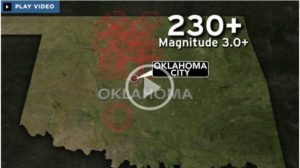 Related news: Earthquakes linked to natural gas fracking in Pennsylvania
Related news: Earthquakes linked to natural gas fracking in Pennsylvania
Attorneys representing the 3,200-member tribe in north-central Oklahoma say the lawsuit is the first earthquake-related litigation filed in a tribal court. If an appeal were filed in a jury decision, it could be heard by a five-member tribal Supreme Court, and that decision would be final.
“Usually tribes have their own appellate process, and then, and this surprises a lot of people, there is no appeal from a tribal supreme court,” said Lindsay Robertson, a University of Oklahoma law professor who specializes in Federal Indian Law.…—Sean Murphy, “Oklahoma tribe sues oil companies in tribal court over earthquake,” GlobalNews Canada, 3/3/17
≈≈≈≈≈≈≈≈≈≈≈≈≈≈≈≈≈≈
And That’s A Wrap! Thanks to all who have written these stories, posted them on their email groups, sent them in directly to us. Much news, good/bad/indifferent, keeps editors hard at work. Thanks! Send, along with budding amyrillis bulbs, to banner@wearesenecalake.com

